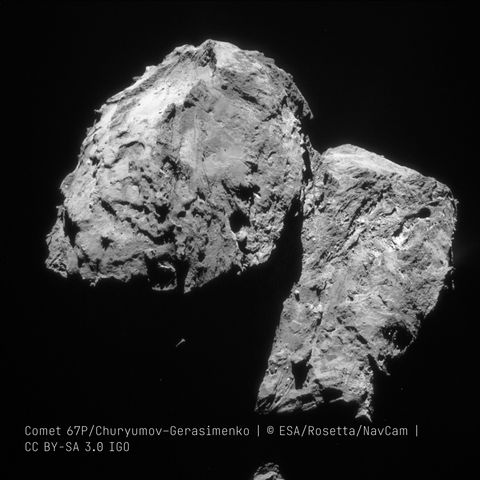Rosetta's primary objective was to contribute to the understanding of the origin and evolution of the Solar System. The composition of the comet served as a valuable indicator, reflecting the composition of the pre-solar nebula from which the Sun and the planets of the Solar System formed over 4.6 billion years ago. Therefore, conducting an in-depth analysis of comet 67P/Churyumov-Gerasimenko by Rosetta and its lander was crucial to acquiring essential information about the formation of the Solar System.

The Journey
Rosetta was launched on 2 March 2004 by an Ariane-5 G+. To place it on the required orbit to rendezvous with Comet 67P/ Churyumov-Gerasimenko it received four gravity assist manoeuvres: 3 from Earth (4 March 2005, 13 November 2007 and 13 November 2009) and 1 from Mars (25 February 2007).
The spacecraft entered deep space hibernation in June 2011 and exited hibernation in January 2014, before rendezvousing with Comet 67P/ Churyumov-Gerasimenko in August 2014. The lander, Philae, was delivered to the comet’s surface in November 2014. Rosetta followed the comet around the Sun, as it moved back out towards the orbit of Jupiter. The mission ended with a controlled descent of Rosetta to the surface of the comet.
Telespazio Germany's involvement in the Rosetta mission:
As the Rosetta mission marks its 20th anniversary today, Telespazio Germany looks back and applauds what it meant. Throughout the mission's journey, Telespazio Germany played a vital role in the Flight Control, Ground Station Operations, Flight Dynamics, and ground systems development Teams of the Rosetta mission ever since the late 1990s.
In support of the European Space Operations Centre (ESA/ESOC) in Darmstadt, the company was involved in:
Development of the Simulator: Telespazio led the development of a sophisticated simulator for the Rosetta orbiter, providing crucial support for flight control activities during all mission phases, including LEOP (Launch and Early Orbit Phase), flybys, hibernation, approach, orbit around the comet, and the soft landing.
Ground Systems Development: Telespazio Germany's expertise extends to the development of key ground systems essential for mission planning, scheduling, monitoring, and control. The Rosetta Mission Planning System (MPS) and Mission Control System (MCS), developed by the company, played pivotal roles in managing the spacecraft's activities over the years.
Operational Expertise: Experts from Telespazio Germany were actively involved in ESOC Flight Control and Flight Dynamics teams, contributing their expertise to ensure the smooth operation of the mission. Additionally, the company's contributions span ICT Engineering, Ground Station Engineering, and Administration.
Support for Philae Lander Operations: In collaboration with the German Aerospace Centre (DLR), Telespazio Germany provided crucial support during various mission phases of the Philae lander. This support included technical management, simulator development, and flight control during the lander's cruise, landing, and scientific operations.
The legacy of the Rosetta mission continues to inspire future generations of scientists and space explorers to push the boundaries of human knowledge and embark on new adventures in space exploration.
Key Scientific Highlights from Rosetta's Comet Mission:
-
Unravelled the origin of Comet 67P's unique double-lobed shape.
-
Provided insights into how the comet's shape influences its seasons and surface dynamics.
-
Discovered molecular oxygen, nitrogen, and water with a unique composition.
-
Identified crucial elements for life's origin, including glycine and phosphorus.
-
Confirmed comets as ancient remnants of the early Solar System.

